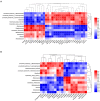Fermented Deer Blood Ameliorates Intense Exercise-Induced Fatigue via Modulating Small Intestine Microbiota and Metabolites in Mice
- PMID: 34063723
- PMCID: PMC8147844
- DOI: 10.3390/nu13051543
Fermented Deer Blood Ameliorates Intense Exercise-Induced Fatigue via Modulating Small Intestine Microbiota and Metabolites in Mice
Abstract
Intense and excessive exercise-induced fatigue has become an important health issue and can damage intestinal health. Deer blood, as a food byproduct with nutritional value, has been found to restore physical strength. However, little is known about the antifatigue effect of fermented deer blood (FDB) on intense exercise mice. The purpose of the present study is to investigate the antifatigue effect of FDB, and whether this effect is correlated with the altered small intestinal microbiota and metabolites in exercise mice. In this study, 5-week-old male C57BL/6J mice are given treadmill exercise with or without FDB supplementation (30 and 150 mg/kg/d) for 3 weeks. FDB significantly reduces metabolic byproduct accumulation, liver and intestinal damage, and enhances glycogen storage and antioxidant capacity in intense exercise mice. Moreover, FDB restructures the small intestinal microbiota by increasing the abundance of probiotics and butyric acid producing bacteria and decreasing the abundance of pathogenic bacteria. FDB also regulates the levels of metabolites involved in TCA cycle and amino acid metabolism in urine and small intestine content. Correlation analysis shows that FDB-modulated microbiota is highly associated with its antifatigue effect. FDB may ameliorate fatigue and intestinal injury through targeting small intestinal microbiota.
Keywords: antioxidant; exercise-induced fatigue; fermented deer blood; intestinal health; metabolomics; small intestinal microbiota.
Conflict of interest statement
The authors declare no conflict of interest.
Figures






References
-
- Zhong L., Ma N., Zheng H., Ma G., Zhao L., Hu Q. Tuber indicum polysaccharide relieves fatigue by regulating gut microbiota in mice. J. Funct. Foods. 2019;63:103580. doi: 10.1016/j.jff.2019.103580. - DOI
MeSH terms
Grants and funding
LinkOut - more resources
Full Text Sources
Medical

